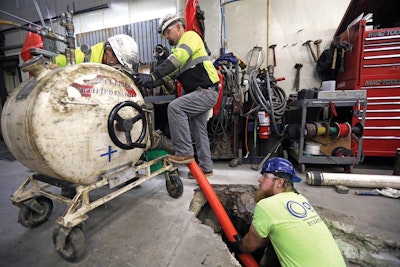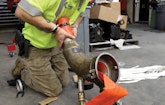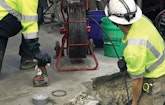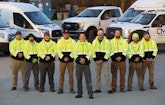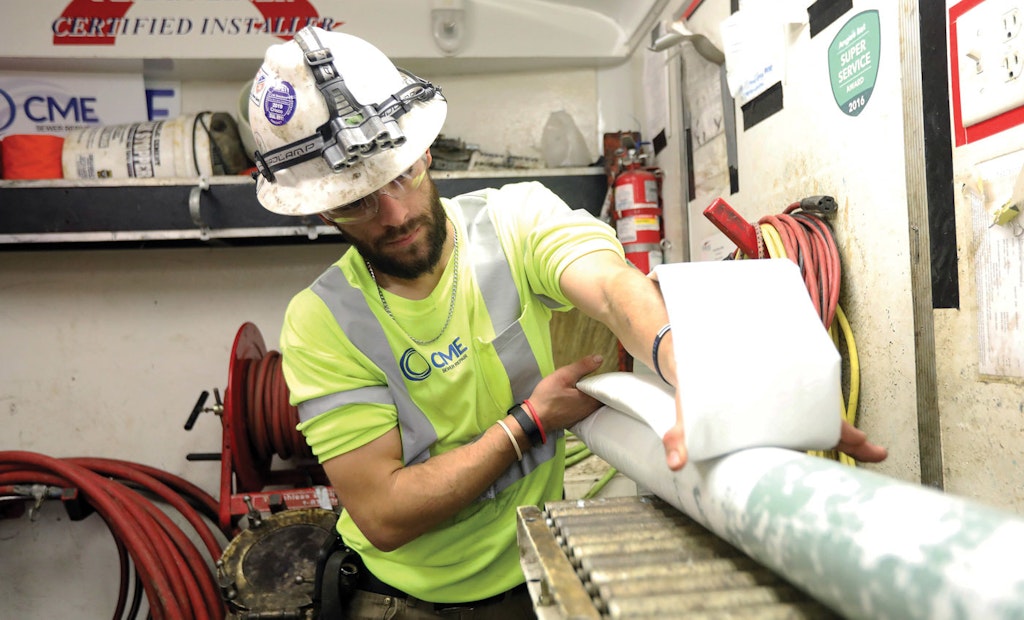Interested in Relining/Rehab?
Get Relining/Rehab articles, news and videos right in your inbox! Sign up now.
Relining/Rehab + Get AlertsA decade ago, Charles “Chuck” Menkhaus, owner of CME Pipe Lining in Cincinnati, saw a change coming to the sewer services market. Traditional dig-and-replace services, his bread and butter, were facing a downward turn with the emergence of trenchless pipe rehabilitation methods.
It was obvious to Menkhaus that this was the future of the industry — and therefore his livelihood — so he jumped in as an early adopter, invested his savings in his first Perma-Liner Industries rig and started offering CIPP relining services. Shifting his focus solely to CIPP lining and trenchless repairs has paid big dividends, and he’s never looked back.
Growing a base
Menkhaus’ core business had been based in the residential lateral repair market, but as CME began to add more lining equipment and personnel, it expanded and now is a healthy mix of residential, commercial, industrial and municipal clients.
Early on, CME understood the need to invest in its branding and marketing to attract clients, and it decided to focus on radio advertising and a strong website. More recently CME has incorporated digital marketing into the mix. “Our radio advertising program has been quite successful,” says Nicole Menkhaus, chief marketing officer of CME. “We have a lot of name recognition in the area from that, but we definitely saw a jump in the number of incoming calls and leads once we started using digital marketing. Everything we do works hand in hand with each other to increase visibility and sales.”
The increased name recognition has opened up opportunities for unusual projects for Menkhaus and the CME team. He readily admits he enjoys a challenge and loves working on projects that require out-of-the-box thinking, or just pure grit, to provide solutions to clients who have an “impossible” problem to solve.
“These types of unique projects occur primarily in the industrial and commercial spaces. We distinguish these two client categories this way: Commercial is any environment that is consumer facing, such as gas stations, retail or office buildings, while industrial is seen as manufacturing and entities that don’t interface with the consumer directly,” Menkhaus explains.
High profile, high priority
CME got a chance to stretch its problem-solving skills when the University of Cincinnati called them to help resolve a mysterious issue in its newly built stadium complex. The locker rooms, which were located on an underground level, had toilets that kept filling with sand, and all previous attempts to clear the sand and resolve the issue had failed. Whatever solution was implemented had to be the least invasive and disruptive as possible to the newly built multimillion-dollar structure, and it had to be done fast, as a big sporting event was scheduled for the coming weekend.
As the toilets filled with sand, maintenance crews would empty the toilets, which would immediately refill. The flow of the incoming sand was described as being like a lava flow, spilling out from the toilets and into the changing rooms. The more the in-house maintenance teams tried to figure it out and resolve it with traditional pipe cleaning methods, the worse the issue became. It was eventually determined that the sand filling the toilets was coming in through an offset pipe that ran under the main plaza and that the sand was the filler that supported the plaza structure. As the sand filled the toilets, it was creating the potential for a dangerous sinkhole and cave-in of the plaza above.
The pipe that supplied the toilets, the one through which the sand was coming in, was 30 feet below a newly built structure and plaza and surrounded by numerous utilities, so traditional replacement with excavation was extremely undesirable. “We were able to come up with a plan to reline the pipe through a small opening in a wall,” Menkhaus says. “It was going to be like performing arthroscopic surgery.”
The line came into the building from a vertical stack located on the outside of the building. The stack was buried, traveling down the outside of the foundation wall, then making a 90-degree turn to come into the locker room at ceiling height. The inflow of the sand was caused by a shifting of the 90-degree fitting, likely resulting from the construction work on the plaza above.
CME worked through the 6-inch conduit that traversed the dressing room’s 2-foot-thick concrete wall. They were able to run 4-inch-diameter pipe through a sleeve they inserted after removing all the broken sections of pipe. This process created a temporary pipe through the access hole in the wall to allow the crews to then perform their CIPP lining process, creating one continuous pipe and joining the previously disconnected sections, including the 90-degree transition bend.
For the lining material, CME utilized 6 mm epoxy Flexi-Liner by Easy Liner. The vertical stack reinstatement was performed using a Dancutter Super Flex reinstatement cutter. After the liner was cured, a structural foam was pumped behind the wall to fill the surrounding space around the pipe to prevent any future movement and help mitigate possible foundational issues caused by the loss of the sand and soil that had been infiltrating the damaged line and toilets.
Quick thinking
Menkhaus is not only resourceful, but he has learned that to be able to take on the tough projects he enjoys, he must be able to react and think quickly, particularly with industrial processing and manufacturing projects.
By focusing his company’s offerings purely on lining, Menkhaus and the CME crews have the advantage of knowledge. Being exposed to the many variables that CIPP lining projects bring on a daily basis, they are able to continuously hone their craft.
“By putting liners in the ground every day, we have been able to build and earn the reputation that we’re the lining company in the area, and that makes us the go-to resource,” he says. “Other sewer contractors offer lots of services like CCTV and cleaning, grouting and more, but we’re different. We want to be No. 1 in one thing; we don’t want to be the No. 10 company that does everything. We know lining, we understand lining, and we know what it can do and what it can’t.”
That level of knowledge is what enabled CME to complete an industrial project in a food processing plant that most other service firms shied away from. They were tasked with rehabilitating a cast iron line that was so eroded that the pipe walls were nonexistent in some areas. This entailed step-lining — installing a CIPP liner in small sections to recreate host pipe walls along the length of the line where there were none. Crews first cleaned a section of line, installed 20 feet of liner and then repeated the process until the entire length of the pipe was reconstructed.
Once complete and cured, this newly created continuous line became the host pipe for the installation of a structural high-temperature liner designed to withstand the factory’s process water and provide a new structurally sound, continuous and seamless line. All this had to be accomplished during the short time window of a holiday plant shutdown. “This is where experience, the knowledge of how sewers work and having the right equipment come into play. In many cases on projects like these, we are going in blind and have to adapt quickly to meet the timeline and combat the unknowns,” Menkhaus says.
Growing pains
Like most businesses that earn a good reputation for quality, expertise and value, CME has experienced rapid growth, going from a microbusiness consisting of Menkhaus, a few crew members, and one lining rig to 17 team members and millions of dollars in lining equipment. Maintaining their reputation is crucial, and Menkhaus recognized the need to enlist the help of his wife, Nicole, a seasoned marketing and operations executive, to join the firm full time and help manage the tasks required in a growing enterprise.
Nicole recognized that, like most small, family-owned businesses, the bulk of the knowledge about the business resides in the owner’s head — and this had to change. “The growth had been very, very rapid, and in order for it to be sustainable, processes and structure had to be developed and put in place so we could train and replicate it consistently,” she says.
Additional personnel to support the firm’s growth were also needed, but before jumping into a hiring blitz, the Menkhauses took a step back and examined what they wanted for the future of the company. Staying lining specialists was a given, but they needed to consider who they wanted to join them in building and sustaining the company’s growth.
“We decided we needed to clearly define our core values and that those values would form the basis of how we would bring people on board,” Nicole says. “We look for candidates who share our values and attitude. If that component is strong, we can teach them the skills they need to do their job. A staff member’s alignment with our culture is now a key ingredient in finding, training and retaining the right talent for our company.”
Those core values include integrity, positive attitude and communication. “We’re creating the next wave of leaders for our industry, so we want our team to communicate honestly, be unafraid of accountability and speak up if something has gone wrong — so we can work together to resolve it. There will always be problems — it’s how you handle them and learn from them that’s important,” she says.
The Menkhauses are also committed to instilling in their team good work habits that include the importance of maintaining the equipment, whether it’s a lining rig or the vehicle itself. “When tools are properly maintained, stress on a job site is reduced significantly and the life span of that equipment investment is extended,” Chuck Menkhaus explains.
They adhere to the old motto: Be good to your equipment and it will be good to you. But in the odd event equipment does go down and successful completion of a project depends on decisive action, Menkhaus won’t hesitate to do what needs to be done, and that includes purchasing equipment on the spot, no matter the cost.
Experience has also taught that many larger industrial or commercial projects are emergency calls, so CME likes to stock adequate quantities of different liners and resins from Easy Liner at any given time so they are ready to deploy to a project site on demand.
Teaching a trade
CME is currently developing a structured training program that will include a plan and career growth path for all new hires. They want to offer an apprenticeship model, giving those new to the industry an opportunity to learn a highly skilled trade in a lucrative career market that has upward mobility both financially and in responsibilities.
“The need for young people to enter the trades is critical,” Nicole says. “Our youth are going to college, whether or not it is right for them, and upon graduation they find themselves in overwhelming debt with a lack of job opportunities that will offer them the level of salary they need to meet their obligations and have a decent life. The trades offer incredible financial opportunities and a chance to one day own your own business, if you have the inclination. Trenchless technology offers work that is technically challenging and diverse, and the industry is growing fast. More high school graduates should be encouraged to look at the trades as a career path.”
Down the line
CME continues to find new opportunities for CIPP lining almost every week, adding and developing new equipment, processes and tricks to meet the needs and the demand of the marketplace. Other trenchless technology closely tied to pipe rehabilitation may also be added, as well as training to help others in the industry. “We’re still growing and developing internally those processes and systems that will ensure the sustainability of our company for the next generation” Nicole says.
“Once this is in place, we are open to different ideas and opportunities to make a difference in the industry, such as training or servicing lining equipment outside of CME. For now, we’re happy to keep working on perfecting what we’re doing and taking on the plentiful body of work that’s out there.”
Attracting new markets
CME Pipe Lining was historically a residential sewer repair company only, but it quickly became clear that CIPP lining, versus the traditional dig-and-replace method, was invaluable for manufacturing plants. To attract industrial manufacturing clients, CME has taken an education-based sales approach, helping plant managers incorporate trenchless technology in small steps to better understand the benefits of no-dig methods versus traditional replacement approaches that can require lengthy plant shutdowns and much higher expenses.
The process begins with CME providing an assessment to identify any signs of damage to the pipe that may be causing the observed issues. Cleaning may be offered to help restore flow in process lines, but this is provided to the client with the understanding that it’s often only a temporary fix. Any damage and underlying causes that were identified during the initial inspection assessment process will not be eliminated through cleaning. A long-term plan for the rehabilitation of the pipe, and thus the long-term resolution of the identified issues, is then given to the client, which in most cases will include utilization of CIPP lining to restore flow and structural integrity to the process lines.
Because manufacturing facilities have variable and often unusual design environments, rehabilitation projects offer owner Charles “Chuck” Menkhaus and his team a chance to stretch their problem-solving skills, something Menkhaus really enjoys and his clients greatly appreciate. One example was the facility engineering manager of a Tier 3 supplier to Chrysler who was experiencing water ingress in a conduit designed to house electrical cables for a new research-and-development area of the plant.
“Spincast epoxy was tried, but the continuous infiltration dissolved the coating. Using higher temperatures for the epoxy was tried next, but this caused clumping on contact with the water, creating clogs in the pipeline,” Menkhaus says. CME was called in to assess the issue, and it was determined that CIPP would be utilized once the existing epoxy lining material was cleared away completely. This was accomplished using a Dancutter Super Flex cutter that was able to navigate the double 45-degree bends in the conduit and grind down the epoxy.
Once cleaned, CME installed a liner in the 10-inch-diameter, 38-foot-long, U-shaped conduit and returned it to service in a matter of hours, eliminating the need to displace the newly installed casting machine and dig up the reinforced concrete pad.
“Being able to offer these trenchless services to industrial facilities is very rewarding for all stakeholders,” Menkhaus says. “We save the client money on the repair itself, as well as eliminating the hidden costs of production shutdown, thanks to our rapid response and minimally intrusive process. We look forward to solving more challenges for the region’s industrial manufacturing facilities — and office buildings, schools and universities, hospitals and nursing homes, and anywhere else we can flex our creative CIPP muscle to help people get on with their lives.”
